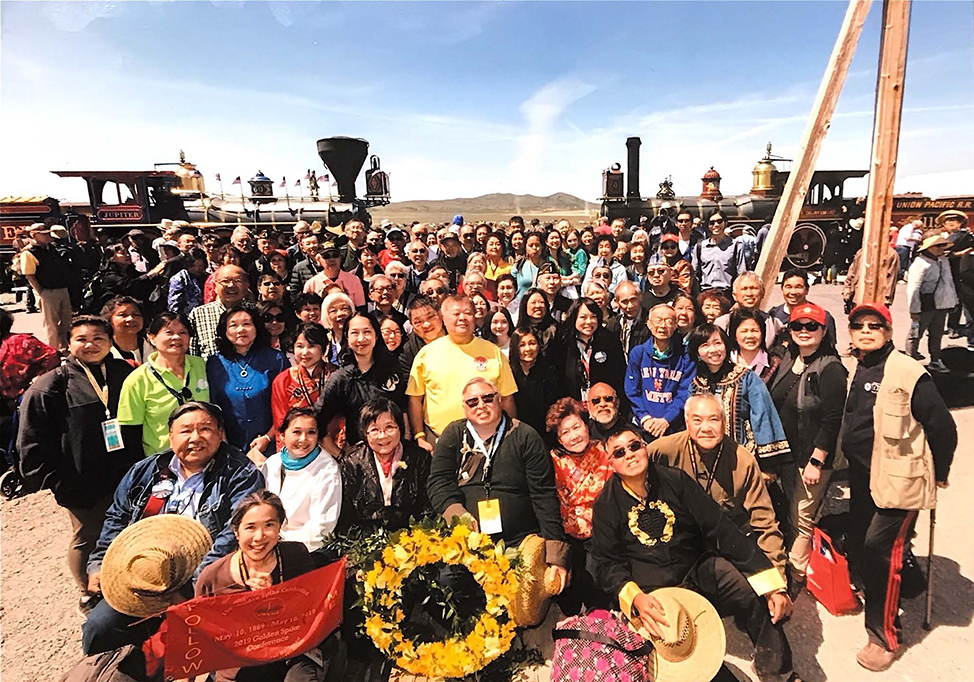By Kevin S. Lee
NORTHWEST ASIAN WEEKLY

Descendants of Chinese railroad workers.
The Chinese philosopher Lao Tzu once wrote, “The journey of a thousand miles begins with a single step.”
My journey to Promontory Summit in Utah to attend the Golden Spike’s 150th Anniversary began with a flight from Sea-Tac airport to Salt Lake City. The Golden Spike’s 150th events celebrate the contributions of the nearly 20,000 immigrant workers from different continents and cultures who helped to complete the first Transcontinental Railroad, nearly 150 years ago. Among them, historians estimate over 15,000 Chinese worked on the railroad during construction. The conference celebrating the Golden Spike’s 150th Anniversary was organized by the president of the Chinese Railroad Workers Descendants Association, Hon. Michael Kwan.

From left: Connie Young-Yu, and Seattleites Bettie Luke, Harry Chan, and Al Young. (Al and Connie are siblings and direct descendants of a Chinese railroad worker). (Photo provided by Al Young)
The week-long conference consisted of lectures, field trips, plays, and concerts that tell the story of the Chinese railroad workers. We attended “The Dance and the Railroad,” a play written by David Henry Hwang; “Gold Mountain,” a play written by Jason Ma; and “Salute to the American Dream: 150th Anniversary of the Golden Spike,” with the Tabernacle Choir and Utah Symphony at Temple Square, conducted by Mack Wilberg and featuring Brian Stokes Mitchell and Megan Hilty.

Promontory Point, the spot where the two railroads joined.
These Chinese workers overcame the harsh environment and racial discrimination, hoping that one day they would bring honor and glory to their families across the ocean. Despite their hopes, many did not live to see the moment of glory or have their bodies transported back to their homeland, due to complicated political interference and warfare. They could only be buried in the soil that was thousands of miles away from their homeland. Fortunately, every year a group of volunteers work on the burial sites to commemorate those lonely souls, expecting nothing in return. They are the volunteers of the Chinese Culture Center.
The Chinese Culture Center was first established to transport the bodies and coffins of the deceased railroad workers from the United States back to Tung Wah Coffin Home in Hong Kong, where the coffins would be transported individually back to their families across China. However, due to the Japanese invasion in World War II and the political unrest in China, the transportation was interrupted, leaving thousands of coffins and bodies behind in Hong Kong and the United States.

The line in purple represents the line laid by Chinese workers. (Photo provided by Al Young)
After China fell into the hands of the Communist Party, it was difficult for Tung Wah Coffin Home to ship the coffins to China. Tung Wah Coffin Home buried those bodies in the Hong Kong Cemetery instead. In the United States, the Chinese Culture Center arranged the burial of the deceased at a local cemetery, instead of assisting the transportation of the coffins. The Chinese Culture Center purchased many burial sites and paid for all related costs. It not only continues to conduct the commemoration annually for free, but also cares and supports other impoverished workers who stayed in the United States after the decline of the railroad.

Photo from the 100th anniversary celebration. Third from right is Mary Yu, mother of Al and Connie Young.
There are more than 500 Chinese workers that are buried in the state of Utah.
It’s has been a learning experience for me discovering the Chinese made up over 90 percent of all railroad workers. Many have been literally forgotten due to poorly kept records. My personal goal was to gain a greater understanding of the hardships and challenges faced by these pioneer Chinese workers.

Photo from the opening of the railroad. No Chinese workers were included.
This week has been full of emotions for me. I laughed, cried, and enjoyed the camaraderie that was built among the attendees of the conference. I met people from across the country and several are old friends I knew from the Chinese American Citizen Alliance, Yee Fung Toy Family Association, and Chong Wa Benevolent Association, to name a few. Leaders from across the country came together to join in the celebration, including Seattleites Bettie Luke, Bettie’s son Michael Kan, Warren Yee, and myself.
We all had a great time and I would recommend the experience to anyone who would like to learn more about the history of the Chinese railroad workers.
Kevin can be reached at info@nwasianweekly.com.



